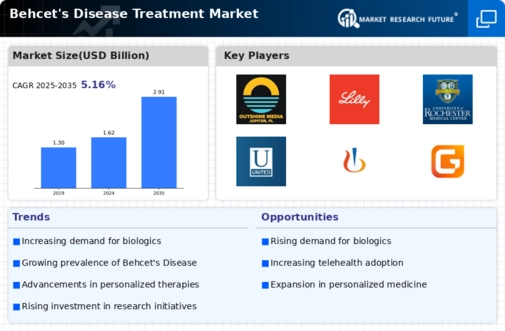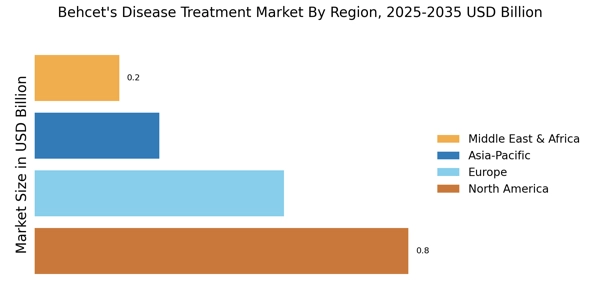Emergence of Telemedicine
The Behcet's Disease Treatment Market is witnessing a transformation due to the emergence of telemedicine, which has become an essential tool for managing chronic conditions. Telemedicine facilitates remote consultations, enabling patients with Behcet's disease to access specialized care without the need for extensive travel. This is particularly beneficial for individuals living in remote areas where access to healthcare providers may be limited. The convenience and efficiency of telehealth services are likely to enhance patient adherence to treatment regimens and follow-up appointments, ultimately improving health outcomes. Moreover, the integration of telemedicine into the treatment landscape may lead to increased patient engagement and education regarding Behcet's disease, fostering a more proactive approach to management. As telemedicine continues to evolve, it is expected to play a pivotal role in shaping the future of the Behcet's Disease Treatment Market.
Growing Patient Population
The Behcet's Disease Treatment Market is influenced by the increasing patient population diagnosed with this complex condition. The disease is characterized by recurrent oral and genital ulcers, skin lesions, and ocular manifestations, which can significantly impact the quality of life. Recent epidemiological data suggests that the incidence of Behcet's disease is on the rise, particularly in regions along the Silk Road, where genetic predispositions may play a role. As awareness of the disease grows among healthcare professionals and patients alike, more individuals are being diagnosed and seeking treatment. This trend is likely to result in a higher demand for effective therapies, thereby propelling the market's growth. Additionally, the need for comprehensive management strategies for Behcet's disease is becoming increasingly apparent, further emphasizing the importance of addressing this condition within the healthcare landscape.
Increased Focus on Patient-Centric Care
The Behcet's Disease Treatment Market is increasingly emphasizing patient-centric care, which prioritizes the needs and preferences of individuals living with the disease. This shift is driven by a growing recognition of the importance of holistic treatment approaches that consider not only the physical symptoms but also the psychological and social aspects of living with Behcet's disease. Healthcare providers are now more inclined to engage patients in shared decision-making processes, ensuring that treatment plans align with their values and lifestyle. This focus on patient-centered care is likely to enhance treatment adherence and satisfaction, ultimately leading to better health outcomes. Additionally, as patient advocacy groups gain momentum, they are playing a vital role in raising awareness and promoting research initiatives, further contributing to the evolution of the Behcet's Disease Treatment Market.
Advancements in Research and Development
The Behcet's Disease Treatment Market is experiencing a surge in research and development activities aimed at discovering novel therapeutic options. Recent studies indicate that the prevalence of Behcet's disease is increasing, with estimates suggesting that it affects approximately 1 in 100,000 individuals in certain regions. This growing incidence has prompted pharmaceutical companies to invest significantly in R&D, leading to the development of innovative treatments such as biologics and targeted therapies. These advancements not only enhance treatment efficacy but also improve patient outcomes, thereby driving the market forward. Furthermore, collaborations between academic institutions and industry players are fostering a conducive environment for breakthroughs in understanding the pathophysiology of Behcet's disease, which may lead to more effective treatment modalities in the future.
Regulatory Support for Innovative Therapies
The Behcet's Disease Treatment Market is bolstered by regulatory support aimed at facilitating the approval of innovative therapies. Regulatory agencies are increasingly recognizing the need for expedited pathways for drugs targeting rare diseases, including Behcet's disease. This support is crucial, as it encourages pharmaceutical companies to invest in the development of new treatments that address unmet medical needs. For instance, orphan drug designations and fast-track approvals can significantly shorten the time frame for bringing new therapies to market. As a result, patients may gain access to cutting-edge treatments more quickly, which could lead to improved management of their condition. This regulatory environment not only stimulates innovation but also enhances competition within the Behcet's Disease Treatment Market, ultimately benefiting patients through a wider array of therapeutic options.


















Leave a Comment